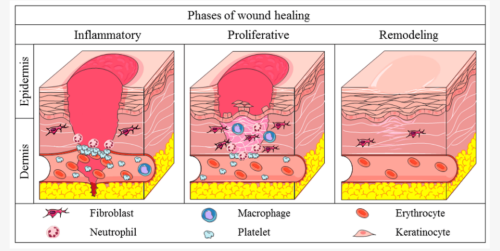
Introduction
Sodium hyaluronate is a derivative of hyaluronic acid. It is making significant strides in the field of wound care, particularly in managing chronic wounds. This breakthrough treatment stands out for its unique properties that not only accelerate the healing process but also ensure a more comfortable recovery for patients.

Figure 1. Wound Healing Process [1]
Chronic wounds, such as diabetic ulcers, venous ulcers, and pressure sores, present a persistent challenge in healthcare, often requiring extensive care and time to heal. Sodium hyaluronate’s emergence as a key player in chronic wound management is transforming treatment approaches. It offers hope for faster recovery and improved quality of life for affected individuals.
The Challenge of Chronic Wounds
Chronic wounds are characterized by their failure to proceed through the normal stages of healing in an orderly and timely manner. Factors such as poor circulation, compromised immune response, and prolonged pressure contribute to the complexity of treating these wounds. Traditional treatments have often fallen short. They might lead to prolonged suffering, risk of infection, and in severe cases, amputation.
The Science behind Sodium Hyaluronate
Sodium hyaluronate is a natural substance found in the human body, particularly in connective tissues and eye fluids. Its ability to retain water and form a gel-like substance makes it an ideal environment for wound healing.
- When applied to a wound, sodium hyaluronate acts as a scaffold that facilitates cell migration and proliferation, essential processes for tissue regeneration.
- Moreover, it maintains a moist wound environment, which has been shown to enhance healing and reduce the risk of infection.
Related reading: From Beauty to Joint Health: Exploring the Versatility of Hyaluronic Acid
Mechanisms of Healing
- Moisture Regulation: Sodium hyaluronate dressings help maintain optimal moisture levels in the wound bed. It prevents desiccation of new tissue and promotes autolytic debridement.
- Barrier Protection: By forming a protective layer over the wound, sodium hyaluronate dressings shield the wound from external contaminants, reducing the risk of infection.
- Enhanced Cellular Function: Its presence of sodium hyaluronate stimulates fibroblast and keratinocyte proliferation, and speeds up the wound healing process consequently.
Clinical Evidence
Studies comparing sodium hyaluronate treatment with conventional wound care methods have demonstrated superior outcomes in terms of healing rate, pain reduction, and overall patient satisfaction. Patients treated with sodium hyaluronate dressings show significantly faster wound closure, decreased incidence of infection, and improved scar appearance.
Application in Chronic Wound Management
The versatility of sodium hyaluronate allows for its use across a spectrum of chronic wounds:
- Diabetic Ulcers: Sodium hyaluronate promotes faster healing in diabetic wounds, which are often slow to heal due to impaired circulation and immune response.
- Venous Ulcers: It provides essential moisture and protection for ulcers caused by poor venous circulation.
- Pressure Sores: Sodium hyaluronate aids in the healing of sores resulting from prolonged pressure, common in bedridden patients.
Advantages of Traditional Treatments
Unlike some traditional wound care products that may dry out the wound or adhere to the wound bed, sodium hyaluronate dressings offer a non-adherent, pain-free removal process. Additionally, their ability to effectively manage exudate without saturating the wound bed sets them apart, providing a cleaner, more conducive environment for healing.
The Future of Wound Care
The integration of sodium hyaluronate into chronic wound management protocols signifies a shift towards more effective, patient-centered care. Ongoing research and innovation in formulation and application methods continue to unlock its full potential. As healthcare professionals increasingly adopt sodium hyaluronate treatments, the outlook for patients with chronic wounds looks increasingly promising.
Conclusion
Sodium hyaluronate represents a significant breakthrough in the management of chronic wounds. It offers a scientifically backed solution that enhances healing, reduces pain, and lowers infection rates. Its role in wound care exemplifies the progress being made in medical treatments. It combines nature’s wisdom with modern science to improve patient outcomes.
As we continue to explore and understand the full capabilities of sodium hyaluronate, its impact on chronic wound management and beyond is expected to grow, marking a new era in therapeutic care.
Stanford Chemicals Company (SCC) specializes as a wholesale supplier of pure organic hyaluronic acid in the USA. Their sodium hyaluronate powder is distinguished by its non-animal source, ensuring it is Vegan and kosher-compliant. Send us an inquiry if you are interested.
Reference:
[1] Gushiken, L.F.S.; Beserra, F.P.; Bastos, J.K.; Jackson, C.J.; Pellizzon, C.H. Cutaneous Wound Healing: An Update from Physiopathology to Current Therapies. Life 2021, 11, 665. https://doi.org/10.3390/life11070665
